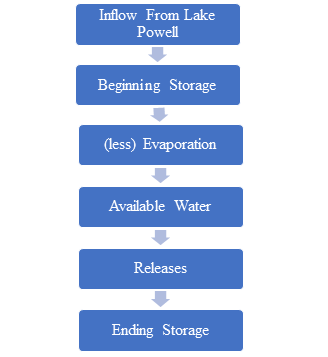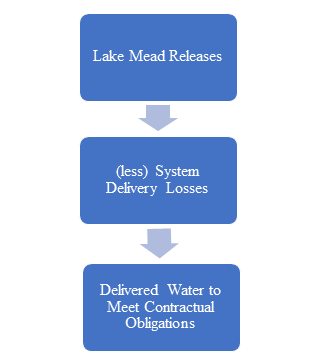The Bureau of Reclamation’s first response to the failure of Colorado River Basin states to propose a plan to reduce the use of Colorado River water by 2 million acre-feet to 4 million acre-feet per year is to recognize evaporation and system losses in the Colorado River system, including the Lower Basin. Channeling the late management guru Peter Drucker, “you can’t manage what you don’t measure.”
Hydrowonk welcomes Reclamation’s interest in understanding how the Colorado River system, in fact, operates. Reclamation’s 2012 Colorado River Basin Water Demand and Supply Study did recognize evaporation and system losses. Unfortunately, confronting the implications for management of the Colorado River, especially in the Lower Basin, evidently fell on deaf ears. Fast forward a decade. The emergency on the Colorado River demands that long-standing neglect be placed in the rearview mirror.
Unfortunately, it looks like Reclamation is about to drive into a ditch. Recognizing evaporation and system losses is part and parcel of the existing water rights regime. Instead, Reclamation seems set on upending the existing water rights regime. The inevitable outcome is litigation and water resource management failure.
There are two parts to the issue. First, what is the scope of Reclamation’s scientific investigation? Second, how should Reclamation use scientific information in determining how available water is managed to meet Reclamation’s contractual delivery obligations to water right holders?
Scope of Reclamation’s Scientific Investigation
In Hydrowonk’s view, Reclamation’s scientific investigation has two parts. First, given Reclamation’s existing operating policies, what are the evaporative losses of reservoirs in the Upper and Lower Basin and the system losses incurred for the delivery of water to water right holders? Regarding the latter, there should be a “bottoms up” approach where the calculations focus on the system losses for each delivery contract. While undoubtedly mind-numbing in detail, the investigation could start with a schematic of the sources and destination of water flows from streams into the mainstem, inflows and outflows of reservoirs, and mainstem segments of releases from upstream reservoirs to downstream reservoirs and water users. The findings would provide a schematic of the “Reclamation Network” of how water flows throughout the Upper Basin, down through and to the Lower Basin and ultimately to the Mexico–United States border.
Second, assess how alternative management strategies impact evaporation and system losses. Would moving water storage upstream to higher elevations reduce evaporative losses? Should Reclamation coordinate operating decisions at Lake Powell and Lake Mead with the other smaller reservoirs on the Colorado River? Adoption of more effective management strategies could be part of long-term reform of how Reclamation manages the Colorado River.
Reclamation’s Use of Information in Meeting its Contractual Delivery Obligations
Evaporation impacts the volume of water Reclamation has available to meet contractual delivery obligations to Colorado River water users (see schematic for Lake Mead Evaporation). Inflows from Lake Powell supplements the volume of beginning water storage at Lake Mead. Evaporation reduces the volume of Reclamation’s available water to meet contractual delivery obligations or to place in ending storage for future years. Available water is either released to meet Reclamation’s contractual delivery obligations or retained in Lake Mead for use in future years.
Schematic of Lake Mead Evaporation
Who bears evaporation losses? The answer is found in Reclamation’s contractual obligations and the Law of the River. By impacting the volume of available water, evaporation losses impact the volume of available water apportioned by the priority system.
System losses means that Reclamation must release more than one acre-foot from Lake Mead to deliver one acre-foot of Colorado River water to downstream water users (see schematic). For example, if system losses were 5% of releases to a water user, then Reclamation must release about 1.053 (1/.95) acre feet of water from Lake Mead to deliver one acre-foot of Colorado River water to delivery points specified in federal water delivery contracts. To deliver 7.5 million acre-feet of Colorado River water to the Lower Basin, Reclamation must release more than 7.5 million acre-feet of Colorado River water from Lake Mead. (The magnitude of this “overage” would reflect the findings for the “Reclamation Network” described above.)
Schematic of Lake Mead Releases
Evaporation and system losses are real, even if they have been historically ignored. As water supplies tighten, the incentive for accurate measurement grows with the need for proper management of the Colorado River. Improving measurement of available water and understanding deliveries and system losses to meet contractual delivery obligations is indeed a very good idea.
Reclamation’s Venture
Hydrowonk has heard reports that Reclamation seeks to apportion evaporation and system losses among all water right owners. To Hydrowonk, this is a fool’s errand.
The priority system already apportions available water. Once again inflows plus beginning water storage less evaporation determines water available for apportionment.
Regarding system delivery losses, water delivery contracts specify delivery points. For example, the U.S. Supreme Court in Arizona v. California recognized 2.6 million acre-feet of Present Perfected Rights for the Imperial Irrigation District based on water use in the Imperial Valley. When the Imperial Irrigation District agreed to a quantification of its Priority 3 right in the Quantification Settlement Agreement, the annual limit of 3.1 million acre-feet was specified at Imperial Dam. In effect, Reclamation uses available Colorado River water in Lake Mead to meet its delivery obligations of all users of Colorado River water in the Lower Basin. Given that agreements specified delivery points for each water user, Reclamation uses available water to meet its delivery obligations and absorb system delivery losses.
“Negotiations” of responsibility for evaporation and system losses involves “trades” among the parties where interests with senior priorities are asked to “concede” water to interests with junior priorities. To reach a consensus, the junior priorities must provide some form of mutually agreeable compensation to senior priorities.
Sound familiar? As Hydrowonk previously noted about Reclamation’s goal of reducing use of Colorado River water beyond the curtailments under the 2019 Drought Contingency Plan, “this sounds like water trading.” https://hydrowonk.com/blog/2022/08/19/the-colorado-river-in-disarray/


